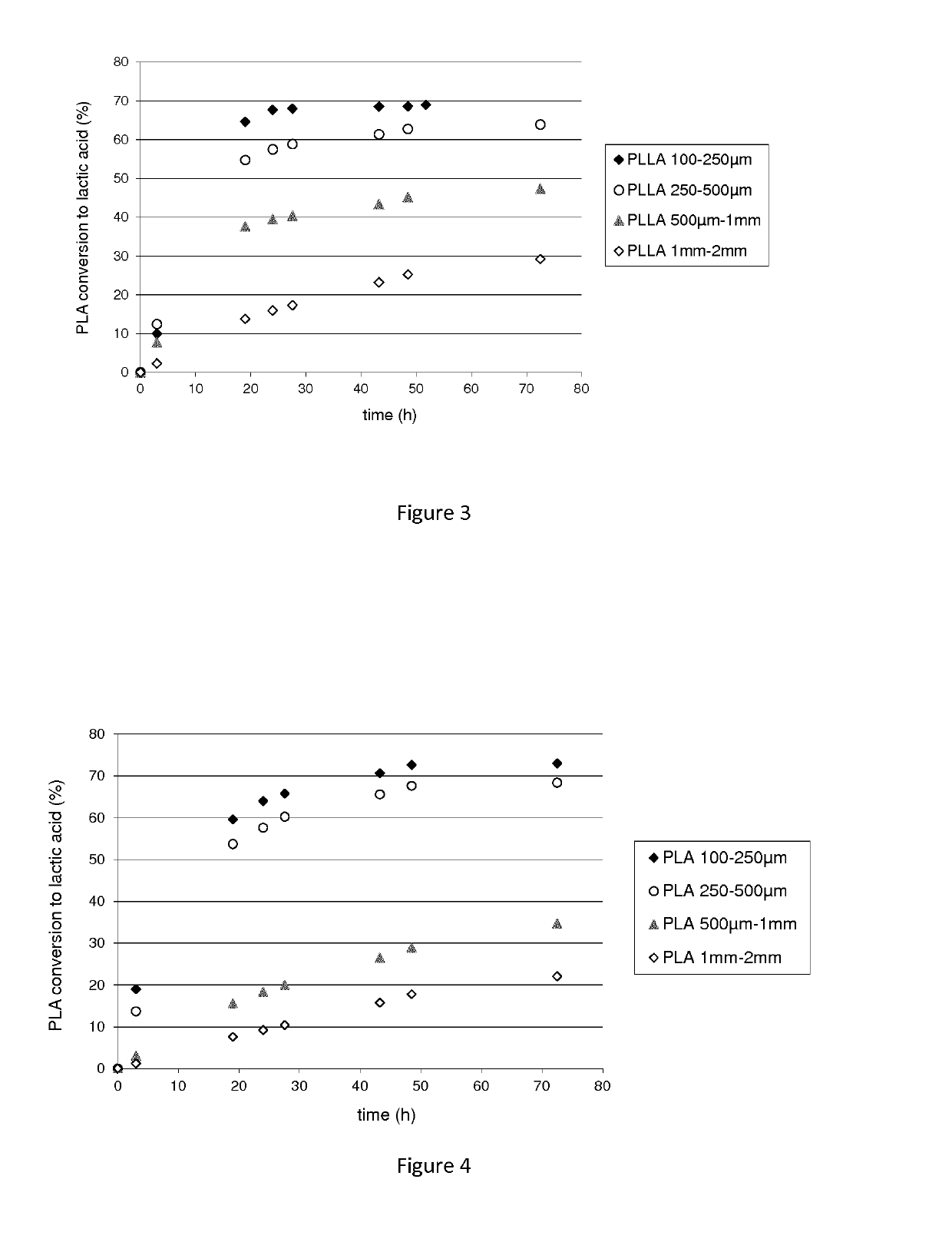Polypeptide having a polyester degrading activity and uses thereof
a polypeptide and polyester technology, applied in the field of new polypeptides having enzymatic activity, can solve the problems of high price, inefficiency of raw plastic products, and inability to meet the requirements of enzymatic reaction conditions, and achieve the effect of increasing the thermostability of polypeptides
- Summary
- Abstract
- Description
- Claims
- Application Information
AI Technical Summary
Benefits of technology
Problems solved by technology
Method used
Image
Examples
example 3
nt of a PLA-Degradation Process
[0179]The aim of these experiments was to solve the problem of producing lactic acid in view of both potential inhibitor and drastically lowering pH during the reaction. The enzyme and the PLA were introduced and confined in a dialysis tube of 10 kDa. This tube is permeable to lactic acid and was placed in a volume of buffer, allowing to work at a constant pH and to dilute lactic acid thus limiting its potential inhibitory effect.
Enzymatic PLA Degradation
[0180]The degradation ability of the polypeptide of interest (SEQ ID NO: 1), was studied during hydrolysis kinetics of PLA. PLA conversion to lactic acid was followed by HPLC analysis.
[0181]The PLA degradation assays were carried out in a 10 kDa dialysis tube (cellulose membrane, width 25 mm, Sigma-Aldrich D9777-100FT). 90 μg of enzyme in 3 mL of Tris HCl 100 mM, pH 8.5 buffer, PLLA powder (Natureplast 500 μm), PLA films (Goodfellow, 50 μm thickness), or PLA objects were introduced and confined in the ...
example 4
n of the Polyesterase Activity on PLA / PLLA of Different Granulometry
[0184]The enzyme activity was evaluated during hydrolysis of PLA powders (PLLA NaturePlast, PLA Ingeo 7001D containing 4% D-lactic acid). Different particle sizes (100-250 μm, 250-500 μm, 500 μm-1 mm and 1-2 mm) were obtained by micronization and grinding of the commercial pellets (Table 1).
[0185]
TABLE 1Characteristics of PLA (Ingeo 7001D) and PLLA (Natureplast)powders: particle size and crystallinity.Particle sizeTg (° C.)Crystallinity (%)PLA Ingeo 7001D100-250 μm623250-500 μm607500 μm-1 mm 63411 mm-2 mm6242PLLA Natureplast100-250 μm5823250-500 μm5724500 μm-1 mm 59341 mm-2 mm6443
[0186]Differential Scanning Calorimetry (DSC) tests were used in order to determine glass temperature (Tg) and crystallinity of PLA, using a Q100 TA-RCS 90 Instrument under nitrogen atmosphere (50 mL / min) at a scanning rate of 10° C. / min from −50° C. to 300° C. in aluminum pans on around 8 mg samples.
[0187]Hydrolysis performances of the two...
example 5
ntration Impact on the Enzyme Activity
[0190]The enzyme activity was evaluated during hydrolysis of PLLA powders at different concentrations (33 to 300 g / L) with the same protocol as described in example 3, 90 lag of enzyme in 3 mL of Tris-HCl 100 mM pH8.5 buffer. The results are presented in Table 2.
[0191]Higher is the PLLA concentration, higher is the productivity of lactic acid formation tending to 0.2 g lactic acid / mg of enzyme / h with a concentration of 300 g / L of PLLA.
[0192]
TABLE 2Productivity obtained at 10 h of reaction during polyesterase-catalyzed hydrolysis of different PLLA concentrations.PLLAPLLAPLLAPLLAProductivity 10 h33 g / L100 g / L200 g / L300 g / LgLactic acid / mgenzyme / h0.070.150.170.19Improvment factor1×2.1×2.3×2.6
PUM
| Property | Measurement | Unit |
|---|---|---|
| molecular weight | aaaaa | aaaaa |
| temperature | aaaaa | aaaaa |
| temperature | aaaaa | aaaaa |
Abstract
Description
Claims
Application Information
 Login to View More
Login to View More - R&D
- Intellectual Property
- Life Sciences
- Materials
- Tech Scout
- Unparalleled Data Quality
- Higher Quality Content
- 60% Fewer Hallucinations
Browse by: Latest US Patents, China's latest patents, Technical Efficacy Thesaurus, Application Domain, Technology Topic, Popular Technical Reports.
© 2025 PatSnap. All rights reserved.Legal|Privacy policy|Modern Slavery Act Transparency Statement|Sitemap|About US| Contact US: help@patsnap.com



